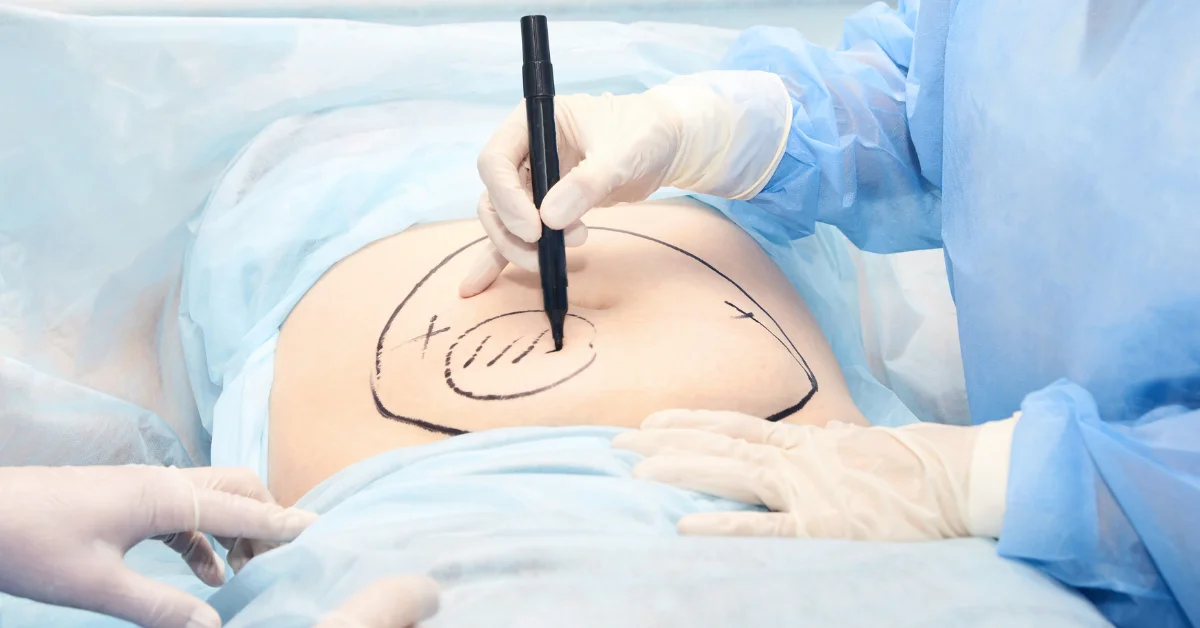Are you tired of endless crunches and fad diets that just don’t seem to make a dent in your stubborn belly fat? If so, you may have considered the option of Stomach Liposuction. This surgical procedure has gained popularity as a quick and effective way to get rid of unwanted belly fat.
In this article, we’ll take you through everything you need to know about stomach liposuction, from understanding the different types to deciding if it’s the right choice for you. If you’ve ever dreamt of a flatter, more defined stomach, read on to discover how this innovative procedure can help you achieve your body goals with speed and precision.
Understanding The Different Types Of Stomach Liposuction
When it comes to sculpting your midsection and getting rid of stubborn belly fat, stomach liposuction is a popular choice. However, not all stomach liposuction procedures are the same. There are different types of stomach liposuction techniques, each with its unique approach and benefits.
1. Traditional Liposuction
- How It Works: Traditional liposuction involves making small incisions in the targeted area and inserting a thin tube called a cannula. The cannula is used to suction out excess fat.
- Ideal Candidates: Suitable for those with localized fat deposits and good skin elasticity.
- Pros: Effective for larger areas, precise fat removal, and long-lasting results.
- Cons: May involve more bruising and longer recovery compared to other techniques.
- How It Works: This technique involves injecting a solution of saline, local anesthetics, and epinephrine into the treatment area. This fluid helps numb the area, reduce bleeding, and facilitate fat removal.
- Ideal Candidates: Suitable for patients who want a less painful and quicker recovery.
- Pros: Reduced pain, swelling, and bruising, as well as enhanced safety during the procedure.
- Cons: The injected fluid can temporarily distort the treated area, making it challenging to evaluate the immediate results.
3. Laser-Assisted Liposuction (LAL)
- How It Works: LAL uses laser energy to liquefy fat cells before suctioning them out. The laser also stimulates collagen production, aiding in skin tightening.
- Ideal Candidates: Suitable for those who desire minimal scarring and a faster recovery.
- Pros: Less bruising, quicker recovery, and potential skin tightening effects.
- Cons: May not be suitable for larger fat deposits.
4. Ultrasound-Assisted Liposuction (UAL)
- How It Works: UAL employs ultrasound energy to break down fat cells, making them easier to remove.
- Ideal Candidates: Suitable for patients with dense or fibrous fat deposits.
- Pros: Effective for larger fat deposits, smoother results, and reduced risk of contour irregularities.
- Cons: Requires experience to avoid over-treatment, potential for thermal injury, and a longer procedure time.
5. Power-Assisted Liposuction (PAL)
- How It Works: PAL uses a vibrating cannula to make fat removal more efficient, reducing physical exertion for the surgeon.
- Ideal Candidates: Suitable for individuals requiring precision and control during fat removal.
- Pros: More efficient and controlled fat removal, potentially shorter surgery duration.
- Cons: May result in a slightly longer recovery compared to some other techniques.
Understanding these different types of stomach liposuction can help you make an informed decision when discussing your options with a qualified plastic surgeon. Your choice will depend on your unique body composition, goals, and the surgeon’s recommendations. Always consult with a board-certified plastic surgeon to determine which type of stomach liposuction is best suited for your specific needs and expectations.
Is Stomach Liposuction Right For You?
Deciding whether stomach liposuction is the right choice for you is a significant decision that should be made after careful consideration of various factors. Here are some key points to help you determine if stomach liposuction is a suitable option for your specific situation:
1. Health and Eligibility
- First and foremost, you should be in good overall health. Pre-existing medical conditions or factors like obesity can increase the risks associated with surgery.
- Your surgeon will evaluate your medical history, current health, and potential contraindications to determine if you are a suitable candidate.
2. Realistic Expectations
- It’s important to have realistic expectations about the results of stomach liposuction. This procedure is not a substitute for weight loss but rather a way to contour and sculpt specific areas.
- Discuss your goals with your surgeon, and make sure they align with what can realistically be achieved through liposuction.
3. Localized Fat Deposits
- Stomach liposuction is most effective for individuals with localized fat deposits in the abdominal area that are resistant to diet and exercise.
- If you have a significant amount of excess skin, your surgeon may recommend a tummy tuck (abdominoplasty) in combination with liposuction for optimal results.
4. Consultation with a Board-Certified Surgeon
- Schedule a consultation with a board-certified plastic surgeon who specializes in liposuction. They will assess your candidacy, discuss your goals, and provide personalized recommendations.
- Use this opportunity to ask questions, voice concerns, and gain a thorough understanding of the procedure.
5. Commitment to Aftercare
- Stomach liposuction requires post-operative care and adherence to your surgeon’s instructions for a successful outcome.
- You must be willing to commit to a healthy lifestyle after the procedure, including maintaining a balanced diet and engaging in regular exercise, to prevent the return of fat deposits.
6. Alternative Options
- Explore alternative non-surgical options for fat reduction, such as CoolSculpting, radiofrequency treatments, or high-intensity focused ultrasound (HIFU), if you have reservations about surgery.
7. Financial Considerations
- Understand the cost associated with stomach liposuction, which may include surgeon’s fees, anesthesia, facility fees, and post-operative care expenses. Ensure that you are financially prepared for the procedure.
8. Mental and Emotional Readiness
- Be emotionally prepared for the surgical process, including the recovery period and potential changes in your body’s appearance.
- Ensure you have a strong support system to assist you during your recovery.
Ultimately, the decision to undergo stomach liposuction should be based on a combination of medical suitability, realistic expectations, and a genuine desire to enhance your body contours. It’s crucial to consult with a qualified plastic surgeon who can provide expert guidance and help you determine if stomach liposuction aligns with your goals and overall well-being. Remember that your safety and satisfaction are paramount, so take your time in making this important choice.
Preparing For Stomach Liposuction Surgery
Preparing for stomach liposuction surgery involves several essential steps to ensure a safe and successful procedure. Here’s a checklist to guide you through the preparation process:
Consultation and Assessment
- Schedule a consultation with an experienced plastic surgeon.
- Discuss goals, medical history, and concerns.
Realistic Expectations
- Understand achievable results and potential risks.
Lifestyle Adjustments
- Quit smoking and reduce alcohol consumption.
- Review and adjust medications as advised.
Medical Tests
- Complete required preoperative tests.
Fasting and Hygiene
- Follow fasting instructions.
- Adhere to pre-surgery hygiene guidelines.
Transportation and Support
- Arrange transportation to and from the surgical facility.
- Prepare a comfortable home recovery space.
- Inform your support system about your surgery date.
Supplies and Documentation
- Stock up on necessary supplies.
- Ensure payment and paperwork are in order.
Postoperative Planning
- Familiarize yourself with postoperative instructions.
- Mentally prepare for the procedure and recovery.
By following this checklist and working closely with your surgeon, you’ll be well-prepared for stomach liposuction, increasing the likelihood of a successful outcome.
The Stomach Liposuction Procedure
The liposuction procedure is a surgical technique designed to remove excess fat from specific areas of the body, including the abdomen, thighs, hips, buttocks, arms, and more. It’s a popular cosmetic surgery option for those looking to contour and reshape their bodies.
Here’s an overview of what to expect during the liposuction procedure:
- Anesthesia: Before the procedure begins, your surgeon will administer anesthesia to ensure your comfort and minimize pain during the surgery. The type of anesthesia used can vary, and your surgeon will discuss this with you during your preoperative consultation.
- Incisions: Small incisions (usually less than half an inch in length) are made in the targeted areas. These incisions are strategically placed to minimize scarring and allow access for the insertion of a thin tube called a cannula.
- Tumescent Solution: In many cases, a tumescent solution is injected into the treatment area. This solution contains a mixture of saline (sterile saltwater), local anesthetics (to numb the area), and epinephrine (to constrict blood vessels and reduce bleeding). The tumescent solution helps to break down fat cells, making them easier to remove and reducing discomfort during and after the procedure.
- Fat Removal: The surgeon uses the cannula to carefully and precisely remove excess fat from the targeted areas. The cannula is connected to a vacuum or suction device, which suctions out the liquefied fat. The surgeon will use various techniques to sculpt and contour the area for the desired result.
- Monitoring and Precision: Throughout the procedure, the surgeon monitors your progress, ensuring that fat removal is evenly distributed and that the contours are symmetrical. The surgeon’s expertise is crucial for achieving optimal results.
- Closing Incisions: After the fat removal is complete, the surgeon closes the small incisions with sutures or surgical tape. In some cases, no sutures are needed, as the incisions are very small and can heal naturally.
- Recovery and Compression Garments: Once the incisions are closed, you may be fitted with compression garments to help reduce swelling and support the healing process. These garments are typically worn for several weeks post-surgery.
- Postoperative Monitoring: After the procedure, you will be closely monitored in a recovery area to ensure your safety and stability. Depending on the extent of the surgery and your individual circumstances, you may be discharged the same day or stay overnight for observation.
Recovery, Aftercare, Risks And Complications For Stomach Liposuction
Recovery and aftercare for stomach liposuction are essential for a successful outcome. Patients will spend time in recovery, wear compression garments, and manage postoperative discomfort with medications. Rest and a gradual return to normal activities are advised. Following the surgeon’s instructions for wound care, medication, and diet is crucial, as is attending follow-up appointments for monitoring.
Despite its benefits, stomach liposuction carries risks and complications. Common risks include infection, bleeding, scarring, and uneven results. Anesthesia-related issues are possible but usually minimized. Skin irregularities or contour deformities can occur if the surgery is not performed skillfully. Rarely, serious complications like deep vein thrombosis or pulmonary embolism may arise. It’s vital to discuss these risks with your surgeon before proceeding with stomach liposuction to make an informed decision.
Read Liposuction Recovery Time and What You Need To Know
Maintaining Results After Stomach Liposuction
Maintaining the results of stomach liposuction requires a combination of lifestyle choices and ongoing care.
- Healthy Diet: Stick to a balanced, nutritious diet with whole foods.
- Regular Exercise: Incorporate both cardio and strength training exercises into your routine.
- Hydration: Stay well-hydrated by drinking enough water daily.
- Portion Control: Be mindful of portion sizes to prevent overeating.
- Avoid Weight Fluctuations: Rapid weight changes can impact results.
- Stable Weight: Maintain a stable and healthy weight.
- Lifestyle Choices: Avoid smoking and limit alcohol consumption.
- Compression Garments: Follow your surgeon’s recommendations on garment usage.
- Postoperative Check-ups: Attend follow-up appointments with your surgeon.
- Sun Protection: Protect your skin from excessive sun exposure.
- Patience: Be patient; results may take several months to fully show.
- Communication: Contact your surgeon if you have concerns or questions about your results.
Conclusion: Is Stomach Liposuction Worth It?
Determining whether stomach liposuction is worth it comes down to a personalized assessment of your objectives, health, and expectations. It’s vital to have realistic goals, as stomach liposuction is most effective for localized fat reduction rather than significant weight loss.
Consulting with an experienced plastic surgeon is a crucial first step, as they can evaluate your candidacy, discuss your specific goals, and provide tailored recommendations. Your overall health and commitment to postoperative care play significant roles in achieving successful outcomes.
Additionally, exploring alternative non-surgical options, considering potential risks and costs, and maintaining realistic expectations are essential factors in making an informed decision. Ultimately, stomach liposuction can be a valuable tool for enhancing body contours and boosting self-confidence when chosen thoughtfully in alignment with your overall well-being.
References
https://www.bodyexpert.online/en/stomach-liposuction
https://www.houstonliposuction.com/blog/five-things-you-need-to-know-about-stomach-liposuction/









